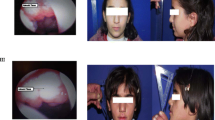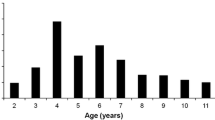Abstract
Adenoid hypertrophy is a normal phenomenon seen in young children. Adenoids may however be of large size or may not reduce in size in adulthood. Large adenoids may cause mouth breathing, overcrowding of teeth or otological symptoms. When adenoids are large and producing these effects, adenoidectomy is necessary. Adenoidectomy immensely benefits such patients but they may still continue to be habitual mouth breathers. This can lead to formation of long narrow face, labially protruded maxillary incisors and class 2 malocclusion. Immediate orthodontic treatment of such patients will improve facial profile and lead to class 1 (Angle) occlusion. We present here a study of 20 patients who were given early orthodontic treatment in postadenoidectomy period as compared to those patients who were not treated by orthodontist.
Similar content being viewed by others
References
Linder-Aronson S (1970) Adenoids: their effect of the mode of breathing and nasal airfl ow, and their relationship to characteristics of the facial skeleton and the dentition. Acta Otolaryngology 265 (Suppl):1–132
Linder-Aronson S (1979) Cephalometric radiographs as a means of evaluating the capacity of the nasal and nasopharyngeal airway. Am J Orthod Dentofacial Orthop 76:479–490
Kerr WJ, McWilliams JS, et al. (1987) Mandibular forma and position related to changes mode of breathing — a five year longitudinal study. Angle Orthod 59:91–96
Cheng MC et al. (1988) Developmental effects of impaired breathing in the face of the growing child. Angle Orthod 58: 309–319
Cooper BC (1989) Nasorespiratory function and orofacial development. Otolaryngol Clin North Am 22(2):413–441
Principato JJ (1991) Upper airway obstruction and craniofacial morphology. Otol Head Neck Surg 104(6)881–890
Rubin RM (1987) Effects of nasal airway obstruction on facial growth. ENT J 66:44–53
Milić (2005) Effects of orthodontic treatment after adenoidectomy on jaw relations in the sagittal plane. Vojnosanit Pregl. 62(4):287–292
Author information
Authors and Affiliations
Corresponding author
Rights and permissions
About this article
Cite this article
Gupta, N., Gupta, S.D., Varshney, S. et al. Orthodontic treatment after adenoidectomy patients: effect on jaw relations in saggital plane. Indian J Otolaryngol Head Neck Surg 61, 153–156 (2009). https://doi.org/10.1007/s12070-009-0057-x
Published:
Issue Date:
DOI: https://doi.org/10.1007/s12070-009-0057-x




